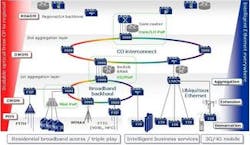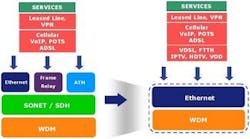By Fred Ellefson
ADVA Optical Networking
The Ethernet movement is evolving in a number of directions--synchronous Ethernet, Ethernet protection switching, Provider Backbone Transport (PBT), service level agreement (SLA) monitoring, circuit emulation, etc.--that, at first blush, might appear random. But a common thread links all of these additions to Ethernet standards; the protocol is being prepared for its next evolution stage: Packet optical transport. In this phase, Ethernet becomes the protocol for transport across an optical-based infrastructure in the access as well as core/regional networks.
Replacing the SONET/SDH transport layer of today's networks with an Ethernet transport layer simplifies network design and dramatically reduces both capital and operational expenditures. Moving away from high-cost SONET/SDH technology is critical for the next phase of network evolution, which is already underway at the network edge and moving toward the core. Development on a variety of Ethernet fronts is making this happen.
Carrier Ethernet and beyond
Historically, Ethernet was a best-effort service carried over the SONET/SDH transport infrastructure.
Created to provide affordable connectivity among computers, printers, servers, and other devices inside a local area network (LAN), Ethernet was extended for inexpensive, simple, connectivity across the wide area network (WAN). Evidence of the carrier's reduced capital and operational costs is found in the cost savings passed on to enterprise customers. On a per-bit basis, Ethernet-based services are priced at about one-sixth the cost of more traditional, leased-line services based on ATM and Frame Relay; 10-Mbit/sec Ethernet and 1.544-Mbit/sec T1 connections run at about the same price.
Still, the economics alone didn't drive wide-scale rollout of "Carrier Ethernet." Originating in the LAN, Ethernet was not inherently optimized for the WAN. Ethernet lacked an operations, administration, and maintenance (OAM) capability, for example. In addition, quality-of-service (QoS) assurance wasn't initially part of the equation. Without the guarantees of SLAs, enterprises were reluctant to trust mission-critical application traffic to best-effort Ethernet services--and carriers were unwilling to offer those Ethernet SLAs without methods to measure and enforce them across a SONET/SDH infrastructure that, in many cases, was leased from other carriers.
Two parallel industry developments at last encouraged the mass-market rollout and uptake of Ethernet-based business services. First, Ethernet OAM standards began bubbling up from the IEEE, ITU-T, Metro Ethernet Forum, IETF, and other groups. Second, hardware and software for monitoring SLAs and testing Ethernet-based services emerged. These industry developments enabled network operators to begin cost-effectively delivering intelligent Ethernet--with full QoS assurance--globally across disparate access media, and a seismic market shift ensued.
Today, intelligent Ethernet services are booming across business markets. Carriers are enjoying significant demand from their business customers for higher and higher bandwidth and more efficient data exchange among offices via SLA-backed, Ethernet-based services.
Toward packet optical transport
Ethernet will forever be a service, but it is now emerging as more than just that. Ethernet's economics are so attractive--and its capabilities have so matured--it is starting to be thought of as a transport-layer protocol for all services across the end-to-end network. Internet access, standard and proprietary business applications, voice, real-time video, and established private-line services can be collapsed onto the Ethernet transport layer.
The SONET/SDH layer has historically shouldered the transport burden, but the overhead of operating both SONET/SDH and Ethernet/Internet Protocol (IP) layers drives higher capex and opex for service providers. To achieve cost reductions, simplified operations, and flexible scalability, operators want to remove the SONET/SDH layer from their networks and utilize a more intelligent Ethernet transport layer in its place.
The fundamental driver behind the economic advantage is Ethernet's reliance on high-volume silicon technology, which benefits from the production volumes of the commercial computer industry. SONET/SDH chips are used only on telecom transport equipment, whereas Ethernet ports appear on every PC, switch, router, and enterprise network device. The greater volume production of chip technology drives substantially lower costs in Ethernet's favor.
Additionally, Ethernet is simpler than SONET/SDH to grow and manage. The protocol is everywhere in enterprise networking. Ethernet's compatibility spans all enterprise client/server systems, personal computers, and upper-layer protocol stacks (TCP/IP, IPX, NetBEUI, etc.) Information Technology (IT) staffs are comfortable working with customer-friendly Ethernet.
Furthermore, Ethernet allows operators to more efficiently scale their networks. High-bandwidth applications are not efficiently supported with SONET/SDH transport. Legacy transport has grown in rigid increments; Ethernet, on the other hand, allows an operator to deploy the precise amount of bandwidth necessary in a given area of the network for optimal resource utilization. And the upper end of those capacity requirements is being expanded every day. With ongoing growth in bandwidth-hungry services such as grid computing, telemedicine, storage, e-commerce, and video-based consumer broadband, packet optical transport capabilities are being enhanced to scale beyond today's 10- and 40-Gbit/sec services to cost effectively support speeds reaching 100 Gbits/sec.
Maturing capabilities
Ethernet's continually expanding role across networking has spurred development on a variety of fronts throughout the standards and vendor communities:
• Synchronous Ethernet: The ITU-T's G.8262 recommendation tackles the synchronization of packet networks to ensure successful transmission of time-sensitive services.
• Provider Backbone Transport (PBT): The IEEE's 802.1Qay standard for PBT encompasses a variety of techniques for delivering SONET/SDH-like OAM and path protection to ensure deterministic service performance across Ethernet transport.
• Ethernet protection switching and ring topologies: The G.8031 and G.8032 standards specify several fault-tolerant architectures for an Ethernet service. The ability to provide 50-m/sec failover between primary and secondary paths and support a variety of both ring and point-to-point topologies protects an Ethernet-based transport layer against fiber cuts or system failures.
• SLA assurance: Standards such as 802.1ag and Y.1731 define ways for network operators to perform in-service performance monitoring on their Ethernet services. In addition, stress-testing tools utilizing the RFC 2544 test suite show a carrier whether its service delivery chain (which encompasses every end-to-end element, including across third-party infrastructure) is primed to meet SLA parameters before the Ethernet service is handed off to the customer.
• Circuit emulation: The MEF's Circuit Emulation over Ethernet (CESoE) borrows on techniques developed to transport TDM services across ATM. CESoE provides the means to transparently carry T1/E1 and other established private-line offerings across Ethernet and is key in Ethernet's evolution from being a service to a transport infrastructure capable of carrying other services.
Ultimately, all of these development areas are driven by the need to ready Ethernet for its inevitable role at the heart of packet optical transport.
Conclusion
The emergence of sophisticated capabilities is enabling network operators to take advantage of Ethernet's superior economics and replace their SONET/SDH transport layers. The evolution is beginning at the network edge and is gradually moving throughout metro, regional, and core networks.
Ethernet's evolution has progressed from LAN infancy; through best-effort, "cheap, dumb pipe" WAN adolescence; to mature, intelligent enabler of high-demand business services such as virtual private networks (VPNs), voice over IP (VoIP), real-time video, and increasingly higher-speed Internet access.
The next stage in Ethernet's evolution is an end-to-end packet optical transport network. Combining optical and Ethernet technologies in a packet optical transport framework creates a future-proof network that is at once cost-effective and sophisticated.
Fred Ellefson is vice president, global marketing, with ADVA Optical Networking. He is an active member of the Metro Ethernet Forum and speaks around the world on intelligent Ethernet, Ethernet demarcation, and Ethernet OAM issues such as RFC 2544 and.802.1ag/Y.1731.
